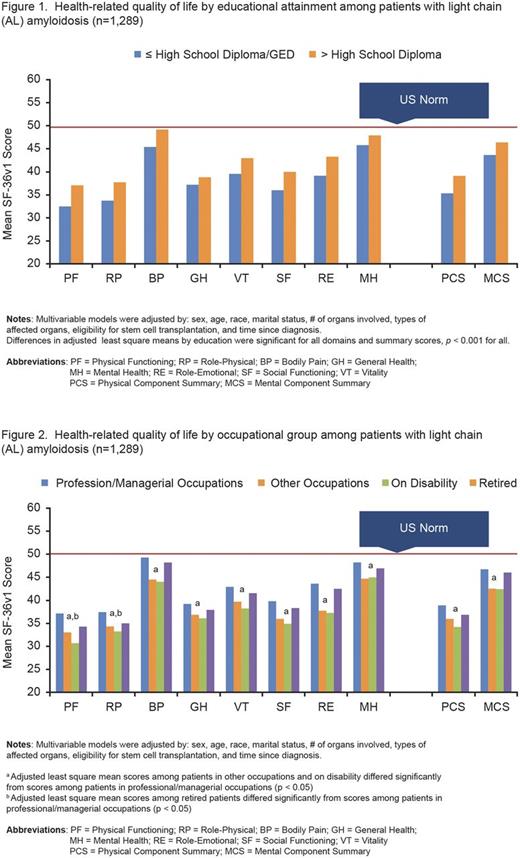Abstract
Introduction: Socioeconomic status (SES) can affect health-related quality of life (HRQoL) through a variety of mechanisms, including poor access to healthcare, physical and mental health comorbidities, low levels of health literacy or health activation, and consequent negative health behaviors. The impact of low SES on HRQoL of patients with AL amyloidosis, however, has not been well described. AL amyloidosis is a rare, complex disease associated with significant organ dysfunction, disability, and death. Although patients with AL amyloidosis report significant HRQoL impairments, it is likely that patients in lower SES groups report even greater deficits. The aim of this study was to assess the impact of SES on HRQoL in AL amyloidosis patients.
Methods : This was a cross-sectional, observational study. A total of 1,289 patients with AL amyloidosis were evaluated at the Amyloidosis Center at Boston University between 1994 and 2014 and completed the SF-36v1 Health Survey within seven days of their initial evaluation. The SF-36v1 assessed HRQoL across eight domains and two component summary measures: physical functioning (PF); role limitations due to physical health problems (RP); bodily pain (BP); general health (GH); vitality (VT); social functioning (SF); role limitations due to emotional health problems (RE); mental health (MH); and physical (PCS) and mental (MCS) component summaries. SES was based on patients' occupation type (ie, professional/managerial positions vs. other occupations, including administrative/clerical, service, blue-collar, and farming positions vs. retired vs. disability) and educational attainment (≤ high school diploma versus > a high school diploma). Regression models using each SF-36v1 domain or summary score as a dependent variable were fit to examine whether there was an association between SES and HRQoL, independent of other demographic and clinical characteristics including type of organ involvement, multi-organ involvement, eligibility for stem cell transplantation, and time since diagnosis. Adjusted least-square means for each SF-36v1 domain and summary were obtained from two sets of models using educational or occupational group as the measure of SES. Established minimally important differences (MIDs) were used to determine whether differences in adjusted mean scores across groups were also clinically meaningful.
Results: The mean age of the population was 61.6 years and the average time since diagnosis was 7.3 months. Based on multivariable models, patients with fewer years of education reported worse HRQoL impairment (i.e., significantly worse scores for all SF-36v1 domain and summary scores) compared to patients with more education (p < 0.05 for all) [Figure 1]. With the exception of GH, MH, and MCS, differences by educational attainment all exceeded the threshold of 1 MID.
In multivariable models using occupation as the independent variable for SES, SF-36v1 scores also differed significantly by occupation (Figure 2). Relative to scores among patients with professional/managerial occupations:
Patients in other occupations reported statistically (p < 0.05 for all) and clinically (i.e. exceeding 1 MID) significant deficits on all SF-36v1 scores.
Patients on disability also exhibited significantly worse SF-36v1 scores (p < 0.05 for all). Deficits exceeded 1 MID for all scores. For PF, VT, and PCS, these differences exceeded 2 MIDs.
Retired patients reported only significant deficits for PF and RP (p < 0.05 for both); however these differences did not meet the threshold for an MID.
Conclusions: Patients from lower SES groups, defined in terms of education or employment, had poorer HRQoL as compared to those with more years of education or professional/managerial positions. These relationships were independent of other clinical variables that served as proxies for disease severity. Outreach efforts designed to increase the understanding of the disease among community-based clinicians should highlight the additional HRQoL burden and potential need for more comprehensive care among patients in lower SES groups. As treatments of AL amyloidosis and healthcare resource utilization can be costly, future research should examine whether SES is associated with costs associated with treatment, type of health care received, and consequently HRQoL.
Supported by Amyloid Research Fund at BUMC and a grant from Prothena Biosciences Inc.
McCausland: Optum: Employment; Prothena Biosciences: Research Funding. White: Prothena Biosciences: Research Funding; Optum: Employment. Yokota: Optum: Employment; Prothena Biosciences: Research Funding. Quock: Prothena Biosciences Inc: Employment, Other: Stockholder. Bayliss: Optum: Employment; Prothena Biosciences: Research Funding.
Author notes
Asterisk with author names denotes non-ASH members.


